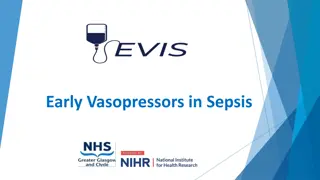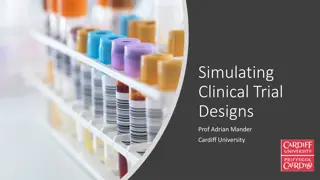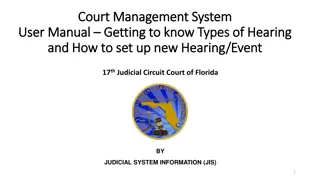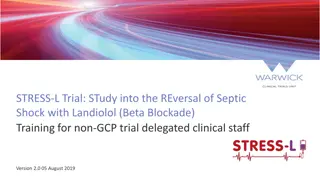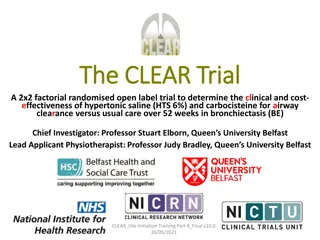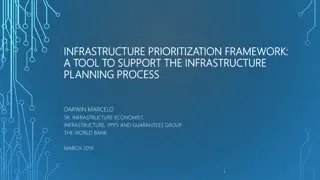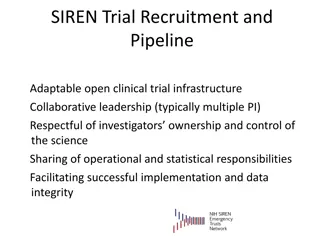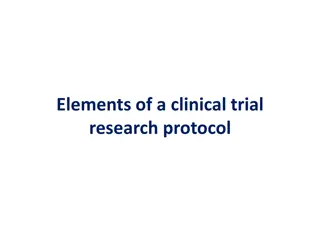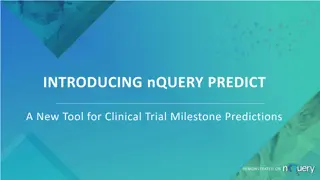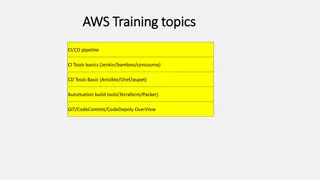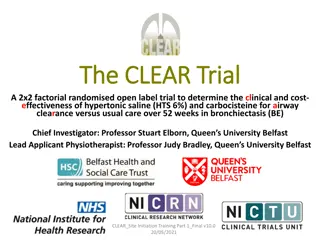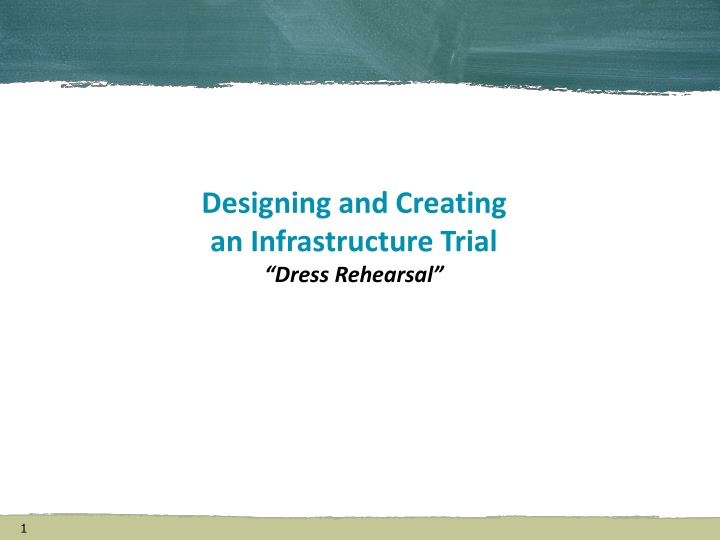
Key Steps for Successful Infrastructure Trial in Education System
Explore the essential components of an infrastructure trial for the PARCC assessment system, including its purpose, participants, access, timing, and necessity. Learn how to ensure readiness for online testing and avoid potential issues during live assessments.
Download Presentation

Please find below an Image/Link to download the presentation.
The content on the website is provided AS IS for your information and personal use only. It may not be sold, licensed, or shared on other websites without obtaining consent from the author. If you encounter any issues during the download, it is possible that the publisher has removed the file from their server.
You are allowed to download the files provided on this website for personal or commercial use, subject to the condition that they are used lawfully. All files are the property of their respective owners.
The content on the website is provided AS IS for your information and personal use only. It may not be sold, licensed, or shared on other websites without obtaining consent from the author.
E N D
Presentation Transcript
Designing and Creating an Infrastructure Trial Dress Rehearsal 1
Topics to be Covered Infrastructure Trial Introduction What , How, When, Where, Why, How: Questions about Infrastructure Trial Getting Started Infrastructure Trial Implementation Models Phases and Steps of an Infrastructure Trial Resources 2
Infrastructure Trial Introduction What is the purpose of an Infrastructure Trial? Answer: The Infrastructure Trial serves as a low-stakes dress rehearsal of our PARCC assessment system. LEAs will review their device, network, and staff readiness to ensure they are prepared for online testing. The trail will utilize the PearsonAccess training platform and does not use real student information. An infrastructure will allow your LEA to confirm: TestNav is configured correctly Devices can successfully run TestNav Network will bear the full load Participating staff are trained and know their roles and responsibilities during testing Students are able to log in and navigate the actual test system. 3
Infrastructure Trial Introduction Who should be involved in an Infrastructure Trial? Answer: Everyone within the LEA who will have a role in the computer- based PARCC assessments could be included in the Infrastructure Trial. Each LEA must decide who to include based on their needs. Test Coordinators Test Administrators LEA technology staff School technology staff 4
Infrastructure Trial Introduction Where do I access the Infrastructure Trial? Answer: The Infrastructure Trial is conducted using the PARCC Training Center at http://PARCC.Pearson.com/TrainingCenter. 5
Infrastructure Trial Introduction When is the Infrastructure Trial? Answer: Plan to conduct an Infrastructure Trial only after you have confirmed site and staff readiness. Louisiana LEAs should complete this trial prior to March 10. Complete training activities Confirm network and assessment environment configuration Develop a communication plan Complete survey on your readiness status 6
Infrastructure Trial Introduction Why is an Infrastructure Trial necessary? Answer: Reviewing set up and communications prior to testing in an Infrastructure Trial can avoid possible problems and delays during the live assessment. Validates device and system configuration set up Provides practice for all participating users Minimal additional activities are needed to conduct an Infrastructure Trial Students and test results are not affected Provides practice of communication plans to be sure everyone knows who to contact for help Allows students practice in the actual test environment 7
Infrastructure Trial Introduction How do I know when the Infrastructure Trial is complete? Answer: The Infrastructure Trial is complete when you can confirm that you are ready for the computer-based assessment. You may use the trial, as needed, to confirm readiness. Check progress with schools Correct configurations and environment settings Try again if needed Make changes to communication plan as needed 8
Infrastructure Trial Introduction Option 1: IT ONLY Ensures: TestNav is configured correctly Devices can successfully run TestNav Network will bear the full load IT Staff knows how to support the test, administrators and users Communication plan around technical challenges is developed 10
Infrastructure Trial Introduction Option 2: IT and DTC Trial Ensures goals of option 1 are covered as well as: IT and DTC staff are trained on both the test system, warnings and processess Ensures both IT and DTC staff know their roles and responsibilities during testing Expands the communication plan to include test administration roles, responsibilities and communications for both IT and DTCs 11
Infrastructure Trial Introduction Option 3: IT, DTC and STC Trial Ensures goals of option 2 are covered as well as: Expands training on both the test system, warnings and processes to STC staff Ensures STC staff know their roles and responsibilities during testing Provides a live test of procedures and test security policies Expands the communication plan to include test administration roles, responsibilities and communications for STC staff 12
Infrastructure Trial Introduction Option 4: IT, DTC, STC, and TA (or TP) Trial Ensures goals of option 3 are covered as well as: Expands training on both the test system, warnings and processes to TA or TP staff Ensures TA or TP staff know their roles and responsibilities during testing Provides a live test of procedures and test security policies Expands the communication plan to include test administration roles, responsibilities and communications for TA or Test Proctor staff 13
Infrastructure Trial Introduction Option 5: All Staff Training plus Student Training Ensures goals of option 4 are covered as well as: Provides a live test of procedures and test security policies Provides students with a chance to practice not only sample questions but also test day procedures (log-in, log-out, warnings or errors) Provides administrators an opportunity to reflects on what policies and procedures may need revising in their communication plan 14
Getting Started: Communication Communication between staff is critical Content Filters Proctor Caching Firewalls Proxies TestNav District IT Communications Special Alerts New Tools New Processes Guidance Training Important Notices Important Notices Test Security Testing Policies & Procedures Test Warnings TestNav IT Communications Testing Policies & Procedures 16
Getting Started: Devising a Plan Devising a Plan LEAs must first determine how detailed and which components of an Infrastructure Trial is required for their school(s) and district. Not all schools or districts need to perform every component. Questions to ask: Have I tested and confirmed all devices can run the test, TestNav is configured properly and the district and school infrastructures can handle the full testing capacity needed? Do all staff know their roles, responsibilities and tasks? Have we tested and communicated our support plans to test administration staff? Are all staff trained and prepared to address all aspects of the tests to ensure a successful test administration? 17
Phases and Steps of an Infrastructure Trial Phase 1 Phase 2 Bandwidth & Hardware Configuration Test Setup, Training and Verification Assessment Environment Configuration Test Administration, Training and Verification TestNav Early Warning System Training and Communication TestNav Configuration in PearsonAccess Test Policy and Procedures Training and Verification Infrastructure Verification Communications and Support Plan Pre-administration Checklist 18
Infrastructure Trial Participants Steps Personnel Responsible Phase 1, Step 1: Bandwidth & Hardware Configuration Phase 1, Step 2: Assessment Environment Configuration Phase 1, Step 3: TestNav Configuration in PearsonAccess Phase 1, Step 4: Infrastructure Verification Phase 2, Step 1: Test Setup, Training and Verification Phase 2, Step 2: Test Administration, Training and Verification Phase 2, Step 3: Test Policy and Procedures Training and Verification Phase 2, Step 4: Communications and Support Plan STC & TA /Proctors IT Staff DTC 19
Bandwidth & Hardware Configuration Phase 1: Step 1 Pearson strongly recommends installing and using proctor caching to locally deliver test content for computer-based assessments Set firewall and content filter permissions to allow all Pearson domains Complete SystemCheck verification on all assessment environments 20
Bandwidth & Hardware Configuration SystemCheck validates testing workstations meet the minimum requirements to run TestNav 8. To gather realistic results, SystemCheck should be run from a student testing machine on the same day of week/time of day as when you anticipate performing online testing. Launch SystemCheck from http://PARCC.Pearson.com/SystemCheck. Learn more about SystemCheck by visiting http://PARCC.Pearson.com/TechInformation. 21
Assessment Environment Configuration Phase 1: Step 2 Assessment Environment Configuration Disable applications that could launch automatically Verify that testing workstations meet minimum requirements Verify that the TestNav content and certificates are trusted on testing workstations. Verify that the latest version of Java is installed and that the Java applet associated with the test is authorized to run. 22
TestNav Configuration in PearsonAccess Phase 1: Step 3 To create and maintain TestNav configurations, log into PearsonAccess and select Configure TestNav from the Test Setup menu NOTE: A user must have the Technology Staff role assigned to their login id to create TestNav configurations. 23
IT Infrastructure Verification Phase 1: Step 4 Infrastructure Verification Once you have completed the first three steps, conduct a trial to verify your device, infrastructure, and assessment configurations for each school in your district and evaluate the outcome. Make adjustments to devices, networks, and re-train staff if necessary. Make sure that everyone with a role in the computer-based assessment understands what to do and who to contact for assistance. 24
Infrastructure Trial: Phase 2 Using the PARCC Training Center http://PARCC.Pearson.com/TrainingCenter 25
Test Setup, Training, and Verification Phase 2: Step 1 IT run through and verifications should be completed and verified before scheduling other testing, training and verification sessions with other staff members. Infrastructure test will use dummy student accounts. Actual test will use real student data, which will be loaded into the system by the Department of Education. The infrastructure trial should mimic the same number of test session to be given as well as the same capacity of simulated students. There is no limit to the number of students or test sessions that can be created in the Training Center. Changes in Training Center do not carry over to live site. All district and school level administrators should be trained in creating dummy student accounts and test sessions. If you are using proctor caching, remember to download the test cache for each proctor server and document who will be performing this task during actual testing. 26
PARCC Training Center Log In The Infrastructure Trial is conducted in the secure PARCC Training Center. 27
Creating Dummy Students Create Dummy Student Data for Practice Create mock students using the Create Students option from the Student Data menu. Create as many students as needed to represent the number of simultaneous test takers that would be tested on a typical day during the live test window. Choose the organization (school), create a class (group) name, select the grade, test name, and choose the number of students you would like to create for practice in the organization you have selected. 28
Creating Dummy Students Continued In the PARCC Training Center, new students created using the wizard will automatically be registered for the computer-based test mode of the test selected in the Create Students step. 29
Test Setup Continued Create Test Sessions for Practice 31
Test Administration, Training, and Verification Phase 2: Step 2 Be sure someone starts the test sessions on or prior to the first day of testing. The system can generate error codes due to lost connectivity, incomplete technology setup, or other factors. Be sure to provide all proctors, school test administrators, and district test administrators with a copy of the codes and instructions on how to handle each one (contact tech staff vs. contact Pearson directly). Conduct one or more training sessions with all testing staff prior to testing period. 32
Test Policy, Procedures Training & Verification Manage Test Sessions 33
Test Policy, Procedures Training & Verification Phase 2: Step 3 Determine, in advance, district rules and responsibilities relating to all aspects of test: Monitoring of students during testing Creating test sessions and dummy students, Starting, resuming, and closing tests Downloading tests when proctor caching Provide all necessary documentation to all involved parties Manuals Error response guidelines Timelines Checklists 35
Communications and Support Plan Phase 2: Step 4 The Communication and Support plan should contain: Roles and responsibilities of every staff member in the testing process Standard communications Routing protocols for issues or anomalies Checklists and tasks to ensure all steps and phases have been completed Follow-up and revision plans 36
Pre-administration Checklist Pre-Administration Coordinate computer-based testing with your Internet service provider Limit high bandwidth network activity other than computer-based testing during the window and avoid technology changes Validate Phase 1-3 Activities have been completed Pre-cache tests by selecting the Proctor Caching button within the Session Details page 37
Testing Security PARCC guidance for testing security policies will be provided in the Test Coordinator and Test Administration manuals Many modern school networks have software installed that allows a teacher s computer to display in real time what is on a student s monitor. LEAs may want to consider policies that clearly disallow the use of such technology during the administration of the test, as this technology can allow exposure of test content intended only for viewing by an individual tester. Many portable electronic devices feature additional functionality such as cameras, text notepads, calculators, and other capabilities that can potentially compromise the security of the test environment. Policies may be needed regarding collection or prohibition of these devices during testing. 39
Testing Security Student access to testing workstations prior to beginning the test should be carefully monitored, in order to ensure that students are not activating software or other resources that could interfere with the security and integrity of the test. Best practices for student testing should ensure that no student is aware of which computer he or she will use for testing until it is time for testing to begin. Any scratch paper or work folders distributed in compliance with the test administration instructions should be collected along with the authorization ticket and stored or disposed of via secure methods, just as would be employed for a paper- based test. 40
Testing Security Testing lab configuration can also help facilitate test security. The following configuration options can help prevent students from viewing another s computer- bases assessment. Placement and spacing of testing workstations Privacy screen filters Computer hoods/visors Once testing has begun, Test Administrators are generally expected to be actively monitoring the entire class of students. Test Administrators may need to be advised not to allow individual issues of a lengthy or complicated nature, such as technical problems with a single student s computer, to distract from their active monitoring role. As a best practice, it is recommended that appropriate IT resources be contacted ahead of time, to be available to assist proctors with such issues. 41
Testing Security LEAs may want to consider a policy for local IT personnel regarding the importance of not viewing secure content within a student s test while trouble-shooting and problem-solving. IT personnel will be required to sign the security agreement so they must attend the same security training that Test Administrators or Test Proctors receive. 42
Training Resources and Modules Training Resources and Modules For Technology Coordinators and Technology Staff: SystemCheck for TestNav Technical Setup Emerging Technologies and Security with Computer-Based Testing http://PARCC.Pearson.com/Support http://PARCC.Pearson.com/TechInformation For Testing Coordinators and Test Administrators: Computer-Based Testing: Test Administration Training Accessibility Features and Accommodations with Computer-Based Testing Paper-Based Testing: Test Administration Training 44
Guides and Manuals Available Guides and Manuals Materials for School Coordinators and Test Administrators PARCC Test Administrator Manual PARCC Test Coordinator Manual for Computer-Based Testing PARCC PearsonAccess User Guide Infrastructure Trial Readiness Guide Materials for LEA and School Technology Coordinators TestNav 8 User Guide TestNav Proctor Caching Guide Quick Start Guides for TestNav 8 and Proctor Caching Infrastructure Trial Readiness Guide PARCC PearsonAccess User Guide 45
Support Contacts PARCC Support Center 888-493-9888 PARCC@support.pearson.com LDOE Contacts TECHNOLOGY: o o o o ASSESSMENT: o o o EdTech@la.gov Carol Mosley (Carol.Mosley@la.gov) Caroline Porche (Caroline.Porche@la.gov) Allen Childress (Allen.Childress@la.gov) Assessment@la.gov Kristina Bradford (Kristina.Bradford@la.gov) Susan Khan (Susan.Khan@la.gov) 46


